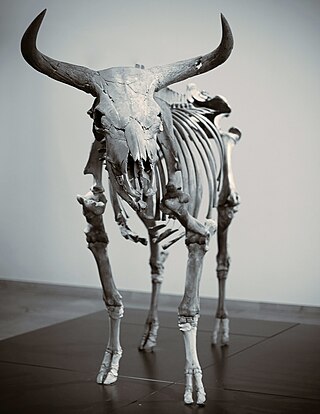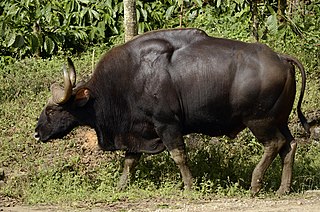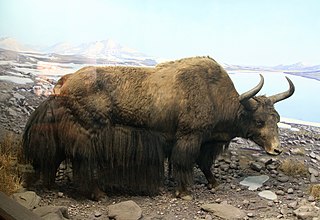
The aurochs is an extinct cattle species, considered to be the wild ancestor of modern domestic cattle. With a shoulder height of up to 180 cm (71 in) in bulls and 155 cm (61 in) in cows, it was one of the largest herbivores in the Holocene; it had massive elongated and broad horns that reached 80 cm (31 in) in length.
Buffalo most commonly refers to:

The zebu, sometimes known in the plural as indicine cattle, Camel cow or humped cattle, is a species or subspecies of domestic cattle originating in South Asia. Zebu, like many Sanga cattle breeds, differs from taurine cattle by a fatty hump on their shoulders, a large dewlap, and sometimes drooping ears. They are well adapted to withstanding high temperatures and are farmed throughout the tropics.

Bovines comprise a diverse group of 10 genera of medium to large-sized ungulates, including cattle, bison, African buffalo, water buffalos, and the four-horned and spiral-horned antelopes. The evolutionary relationship between the members of the group is still debated, and their classification into loose tribes rather than formal subgroups reflects this uncertainty. General characteristics include cloven hooves and usually at least one of the sexes of a species having true horns. The largest extant bovine is the gaur.

Bos is a genus of bovines, which includes, among others, wild and domestic cattle.

The gaur, also known as the Indian bison, is a bovine native to South Asia and Southeast Asia, and has been listed as Vulnerable on the IUCN Red List since 1986. The global population was estimated at a maximum of 21,000 mature individuals in 2016, with the majority of those existing in India.

The yak, also known as the Tartary ox, grunting ox, or hairy cattle, is a species of long-haired domesticated cattle found throughout the Himalayan region of Gilgit-Baltistan, Nepal, Sikkim (India), the Tibetan Plateau, (China), Tajikistan and as far north as Mongolia and Siberia. It is descended from the wild yak.

The Heck or Munich-Berlin is a German breed or type of domestic cattle. It was bred in the 1920s by Heinz and Lutz Heck in an attempt to breed back the extinct aurochs. Controversy revolves around methodology and success of the programme. There are considerable differences between Heck cattle and the aurochs in build, height, and body proportions. Furthermore, there are other cattle breeds which resemble their wild ancestors at least as much as Heck cattle.
Taurus is Latin for 'bull' and may refer to:

The gayal, also known as the Drung ox or mithun, is a large domestic cattle distributed in Northeast India, Bangladesh, Myanmar and in Yunnan, China.

The banteng, also known as tembadau, is a species of wild bovine found in Southeast Asia.

Chillingham cattle, also known as Chillingham wild cattle, is a breed of cattle that live in a large enclosed park at Chillingham Castle, Northumberland, England. In summer 2022 the cattle number 138 animals with approximately equal numbers of males and females The herd has remained remarkably genetically isolated for hundreds of years, surviving despite inbreeding depression due to the small population. There is also a small reserve herd of about 20 animals located on Crown Estate land near Fochabers, North East Scotland.
A yak is a long-haired species of cattle. There are two types of yak:
Busa or BUSA may refer to:
Bos is a genus of domestic cattle.

The tribe Bovini or wild cattle are medium to massive bovines that are native to Eurasia, North America, and Africa. These include the enigmatic, antelope-like saola, the African and Asiatic buffalos, and a clade that consists of bison and the wild cattle of the genus Bos. Not only are they the largest members of the subfamily Bovinae, they are the largest species of their family Bovidae. The largest species is the gaur, weighing up to 1,500 kg (3,300 lb).

Cattle are large, domesticated, bovid ungulates widely kept as livestock. They are prominent modern members of the subfamily Bovinae and the most widespread species of the genus Bos. Mature female cattle are called cows and mature male cattle are bulls. Young female cattle are called heifers, young male cattle are oxen or bullocks, and castrated male cattle are known as steers.

The wild yak is a large, wild bovine native to the Himalayas. It is the ancestor of the domestic yak.

Hariana or haryanvi is an Indian breed of cow native to North India, specially in the state of Haryana. They produce about 10 to 15 litres of milk a day, compared to 8.9 litres when cross-bred with Holstein Friesian cattle (HS), whereas pure HS can produce 50 litres a day, but it is not as disease-resistant in the conditions of North India.
Wild Cattle may refer to:













